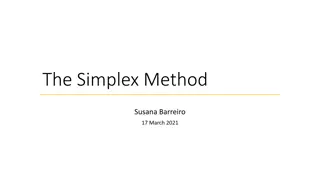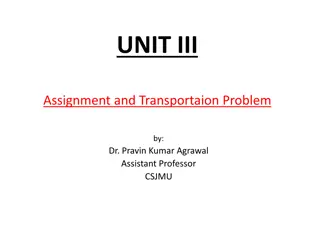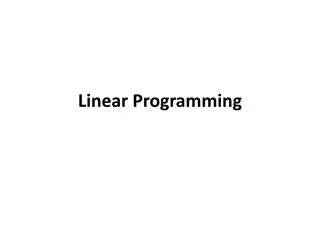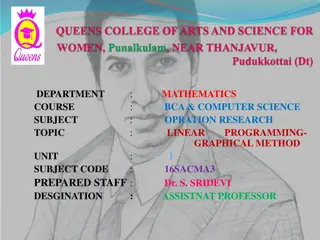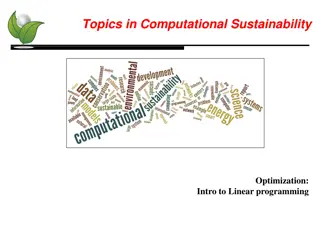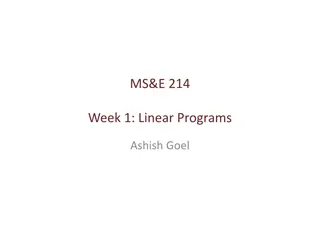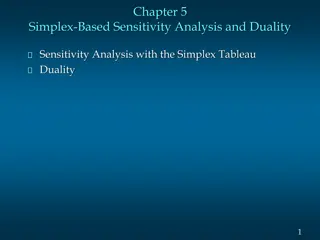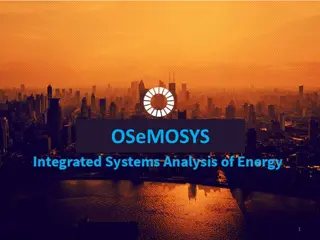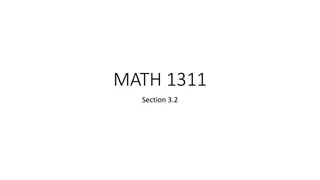Overview of Linear Programming Problems in Operations Research
Linear programming problems (LPP) play a crucial role in Operations Research by optimizing resource allocation through decision variables, objectives, and constraints. Understanding the components and solutions of LPP helps in determining feasible and optimal solutions for real-world problems efficiently.
Download Presentation

Please find below an Image/Link to download the presentation.
The content on the website is provided AS IS for your information and personal use only. It may not be sold, licensed, or shared on other websites without obtaining consent from the author.If you encounter any issues during the download, it is possible that the publisher has removed the file from their server.
You are allowed to download the files provided on this website for personal or commercial use, subject to the condition that they are used lawfully. All files are the property of their respective owners.
The content on the website is provided AS IS for your information and personal use only. It may not be sold, licensed, or shared on other websites without obtaining consent from the author.
E N D
Presentation Transcript
LINEAR PROGRAMMING PROBLEM DALLY MARIA EVANGELINE A ASSISTANT PROFESSOR OF MATHEMATICS BON SECOURS COLLEGE FOR WOMEN THANJAVUR, TAMIL NADU
OPERATIONS RESEARCH OPERATIONS RESEARCH O.R. is the application of scientific methods, techniques and tools to problems involving the operations of a system so as to provide those in control of the system with optimum solutions to the problem. It is a scientific knowledge through interdisciplinary team effort for the purpose of determining the best utilizing of limited resources.
LINEAR PROGRAMMING PROBLEM LINEAR PROGRAMMING PROBLEM Linear Programming Problem, abbreviated as L.P.P., is a technique for determining an optimum schedule of interdependent activities in view of the available resources. Programming, is just another word for planning and refers to the process of determining a particular plan of action from amongst several alternatives. The word linear stands for indicating that all relationships involved in a particular problem are linear.
COMPONENTS OF LPP COMPONENTS OF LPP A Linear Programming Problem consists of three components, namely decision variables,objective and constraints (restrictions). The decision variables refers to the activities that are competing one another for sharing the resources available. All the decision variables are considered as continuous, controllable and non negative. A linear programming problem must have an objective which should be clearly identifiable and measurable in quantitative terms. There are always certain limitations (or conditions, constraints) on the use of resources, such as labour, space, raw materials, money etc. that limit the degree to which an objective can be achieved.
GENERAL LINEAR PROGRAMMING GENERAL LINEAR PROGRAMMING PROBLEM PROBLEM Given a set of m-linear inequalities or equations in n-variables, we have to find non-negative values of these variables which satisfy the constraints and maximize or minimize some linear function of the variables. Optimize (maxi or mini) Z = ?1?1+ ?2?2+ + ???? (1) Sub to the constraints ?11?1+ ?12?2+ + ?1??? ,=, ?1 ?21?1+ ?22?2+ + ?2??? ,=, ?2 .. ??1?1+ ??2?2+ + ????? ,=, ?? With non-negative restrictions , ?? 0 .. (3) (2)
SOLUTIONS OF LPP SOLUTIONS OF LPP ?,(? = 1,2, ?), Solution: The values of the variables ?? that satisfies the equation (2) is called solution to the given LPP. Feasible solution: A solution that satisfies the equation (3), that is, the non negativity restriction is called feasible solution of the given LPP. Optimal solution: A feasible solution that optimizes the objective function (1) is called an optimal solution of the given LPP.
CONVERSION OF INEQUALITY INTO CONVERSION OF INEQUALITY INTO EQUALITY EQUALITY Slack variable: A positive variable added to the LHS of the constraints (2) of the given LPP in order to convert the ( ) less than or equal to type constraint into an equation is called an slack variable. Surplus variable: A positive variable subtracted from the LHS of the constraints(2) of the given LPP in order to convert the ( ) greater than or equal to type constraint into an equation is called an surplus variable.
SIMULTANEOUS LINEAR EQUATIONS SIMULTANEOUS LINEAR EQUATIONS Given m-simultaneous linear equations in n unknown (m<n). Given ? ? = ? ? ?????= ??,(? = 1,2, ,?) ?=1 ? = [???]? ?, ? = [?1,?2, .,??] and where [?1,?2, ,??]. Let ? is an ? ? matrix of rank m. Let ? be a column matrix of m rows. Degeneracy: A basic solution to ? ? = ? is degenerate if one or more of the basic variables vanish. ? =
SOME IMPORTANT RESULTS SOME IMPORTANT RESULTS A necessary and sufficient condition for the existence and non degeneracy of all possible basic solutions of ? ? = ? is the linear independence of every set of m columns from the augmented matrix ?? = ( ?, ?). A necessary and sufficient condition for any given basic solution ??= ? 1 ? to be non-degenerated is the linear independence of ? and every set of (m-1) columns from ?.
SOME IMPORTANT THEOREMS SOME IMPORTANT THEOREMS If a linear programming problem has a feasible solution then it also has a basic feasible solution. There exists only finite number of basic feasible solutions to linear programming problem. If a linear programming problem have a basic feasible solution and we drop one of the basic vector and introduce a non-basic vector in the basis set, then the new solution obtained is also a basic feasible solution. Any convex combination of k-different optimum solution to a linear programming problem is again an optimum solution to the problem.
GEOMETRIC INTERPRETATION OF L.P.P. GEOMETRIC INTERPRETATION OF L.P.P. Whenever the feasible solution of linear programming problem exists, the region of feasible solution is a convex set and there also exist extreme points. If the optimal solution exists one of the extreme point is optimal. Whenever the optimal value of objective function Z is finite, at least one extreme point of the region of feasible solution has an optimal solution. If optimal solution is not unique, there are points other than extreme points that were optimal, but in any case one extreme point is optimal.
METHODS TO SOLVE L.P.P. METHODS TO SOLVE L.P.P. Graphic method of solution: L.P.P. involving two decision variables can easily be solved by graphical method. In this method, it is always associated with corner points (extreme points) of the solution space. The Simplex Method: It is a mathematical treatment to obtain and identify these extreme points algebraically. Use of Artificial Variables: In order to obtain an initial basic feasible solution, we first put the given L.P.P. into its standard form and then a non-negative variable is added to the left side of each of equation that lacks the much needed starting basic variables. The so- called variable is called an artificial variable.
SOME IMPORTANT THEOREMS SOME IMPORTANT THEOREMS FUNDAMENTAL THEOREM OF LINEAR PROGRAMMING: If the feasible region of an L.P.P. is a convex polyhedron, then there exists an optimal solution to the L.P.P. and at least one basic feasible solution must be optimal. UNBOUNDED SOLUTION: Let there exist a basic feasible solution to a given L.P.P. If for at least one j, for which ??? 0 i = 1,2, ,m ,and ?? ?? is negative, then there does not exist any optimum solution to this L.P.P. CONDITIONS OF OPTIMALITY: A sufficient condition for a basic feasible solution to an LPP to be an optimum (maximum) is that ?? ?? 0 for all j for which the column vector ?? ? is not in the basis B.
DEGENERACY IN LINEAR PROGRAMMING DEGENERACY IN LINEAR PROGRAMMING The phenomenon of obtaining a degenerate basic feasible solution in a linear programming known as Degeneracy. Degeneracy in an L.P.P. may arise (i) at the initial stage and (ii) at any subsequent iteration stage. The condition of degeneracy reveals that model has at least one redundant constraint. Alternative optima Unbounded solution Infeasible solution




